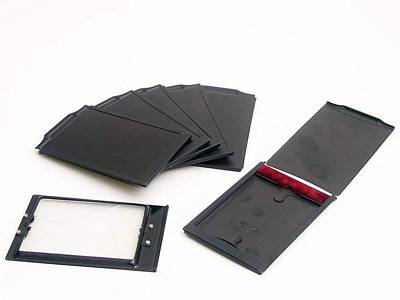| Envoy Wide Angle Camera and Developing Tank |
 |
|||||||||||||||
|
|
|||||||||||||||
|
The Envoy Wide Angle is not, strictly, an Ilford camera, as it was not badged with the Ilford name. However, since it was manufactured by the same company making the cheap, plastic, Ilford Envoy box camera (Photo Developments Ltd; Leonard Road, Handsworth, Birmingham 19, England), it is usually associated with Ilford Ltd. Also, Ilford marketed the Envoy Wide Angle through their General Catalogue of Photographic Materials. The Envoy Wide Angle is not to be confused in any way with the cheap amateur Ilford Envoy box camera; it was a specialist precision instrument used by professionsals. As its name suggests, the Envoy Wide Angle was a camera specially designed for wide-angle photography and is believed to have been sold throughout the 1950s. It takes 8 off 2¼" x 3¼" (conventionally referred to as 6 x 9cm) images on 120 or 620 roll film or used 2½" x 3½" plates in single metal holders. The body is of die-cast metal with a leather covering, of overall size 4¾" x 3¾" x 2½" (12cm x 9.5cm x 6.5cm) and weighs 17ounces (480grammes). The viewfinder is a simple
open wire frame 'sports finder' type, with parallax adjustment
on the rear sight. The lens is a bloomed f6.5 Taylor, Taylor,
Hobson Ltd of 64mm focal length, of 4-element construction. The
acceptance angle is 82degrees, the equivalent of a 25mm focal
length lens on a 35mm film camera - hence, a quite reasonable
wide angle. Although the lens opens up to f6.5, the recommended
usage starts at f11 and down to f32. With its fixed focus, the
camera can be used "point and shoot", with a resulting
high quality large negative. The approximate depth of focus at
different stops is as follows: By 1955 (see Ilford Photographic
Materials General Catalogue), the Envoy Wide Angle was available
in three models: The following pictures have kindly been made available to me by London based photographer, Gary Alexander, who owned and used the illustrated Envoy Wide Angle. Gary has 'posted' a selection of his Envoy images to his own web site see: http://www.gaspweb.co.uk/cameras/envoy.html. Gary's home page is at http://www.gaspweb.co.uk/. |
|||||||||||||||
 |
 |
||||||||||||||
|
Note that this is the fully synchronised Synchro-Compur model |
|
||||||||||||||
 |
 |
||||||||||||||
|
|
|
||||||||||||||
 |
 |
||||||||||||||
|
|
|
||||||||||||||
 |
 |
||||||||||||||
|
|
|
||||||||||||||
 |
Original sturdy leather outfit case, contains the camera with 6 dark slides, the ground glass viewing screen and Envoy developing tank for cut film or plates (see below). The Envoy Wide Angle came with
a 6 page users manual. Click the image below to view all 6 pages
as an Adobe Acrobat (*.pdf) file. Please note that this version
is not a precise copy of the original as I have applied an OCR
program to the original scan and also inserted a higher quality
image on the front page. Adobe Reader software is freely distributed and is available from many web sites, e.g. http://www.adobe.com/uk |
||||||||||||||
 |
|||||||||||||||
|
This advertisement, taken from 'Photography' magazine, November 1951, Vo. 6, No.11, shows the "Envoy" Wide Angle Camera advertised by its manufacturers, Photo Developments Ltd. A 4-shutter speed outfit is priced at £33.4s.9d (£33.24p), and an 8 speed outfit costs £36.14s.9d (£36.74p). Plate holders were 10s.4d each (52p) and cut film sheaths cost 1s.11d each (10p). (These prices are slightly different from the prices taken from Ilford's catalogue, quoted at the top of this page) |
|||||||||||||||
|
Alongside is shown the Envoy Developing Tank for 2½" x 3½" plates, suited to the Envoy Wide Angle camera. The tank took 4 plates at a time and used 5fluid ounces of developer (142cc). It cost 16s.6d in the mid-1950s (83p) and measures 135mm long, by 85mm tall by 50mm wide (maximum dimensions). It was made in England of black Bakelite. This example was donated by Brian Rees. Envoy (Photo Developments Ltd) made similar tanks to hold larger plates, 3¼"x4¼", costing 18s (90p) and needing 7fluid ounces of developer, and 9cmx12cm, costing £1.3s (£1.15p) and needing 10fluid ounces of developer (285cc). |
|
||||||||||||||
|
|
The construction was very simple, consisting of a push-on light-tight lid with a light baffled filling opening at one end (LHS in picture) and a emptying 'spout' at the other. Agitation was (presumably) by tilting the tank from end to end and/or from side to side. There is no facility to insert any sort of agitation implement. |
||||||||||||||
|
The internal construction is just a notched chamber to hold the four plates. |
|||||||||||||||
|
|
The loading jig came in a box covered in the same brown & gold stripes as the developing tank (see above). The instructions read: This accessory is a particularly
simple aid for changing-bag, or within-bed loading. It is therefore
a boon to tourists who must necessarily load their material under
difficult conditions.
|
||||||||||||||
 |
A plate with this image was found within the Envoy tank (see picture above). It was very under-exposed but, using the miracle of digital technology, has been enhanced here to show the profile of an attractive young lady, maybe from the late 1950s or 1960s. Does anyone recognise her? |
||||||||||||||
|
|
|||||||||||||||
|
|
|||||||||||||||
